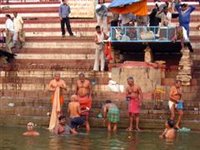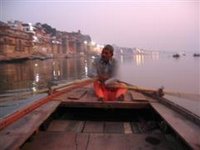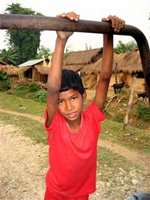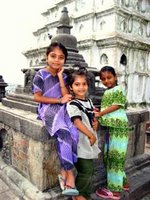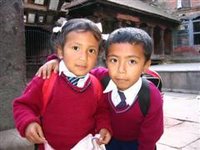This album is powered by
BubbleShare
- Add to my blog
We’ve been lucky to be healthy so far on this trip, but we finally had to pull out the first aid kit: somewhere between Bhaktapur and Pokhara, Alex pulled a muscle in his back and could barely walk or move without hunching over in pain. We planned to trek together in Pokhara, and Alex encouraged me to go without him while he recuperated.
Pokhara is situated on a lake surrounded by the towering snow-capped Himalayan Mountain range, and is famous for trekking the Annapurna Circuit. “Three Sisters Adventure Trekking,” a female guide service was created by the three Chhetri sisters in response to the gross inequality of women in Nepal. Their training program, “EWN” (“Empowering the Women of Nepal”), teaches women to become trek guides to gain economic independence. They say: “Women do not need sympathy, they need opportunity. Why not hire a woman trekking guide?” (So this is what the running girls can do when we retire!)
My guide, Madhu (pictured), was a diminutive (even shorter than me!), 36-year-old single mother of two daughters, ages 12 and 7. She explained to me that the “Three Sisters” program gave her the opportunity to earn more money as a trekking guide to support her family. Madhu told me how she had wanted to “go to university,” but had to work to help support her brother and three sisters. We discussed the lingering caste system in Nepal, and the strong preference for male children to support the family, although she admitted that her own brother, who now earns good money, does not help support anyone else in the family.
Over the next two days we hiked through Gurung farm villages, climbed mountain trails and slept in a small guest house, all under the shadow of the snow-peaked Himalayas. I enjoyed every part of the trek: the farm villages; the warm smiles and “Namaste” greetings from the gentle Nepali people; the buffalo who would gaze at me with big brown eyes; and Madhu sharing with me about her family, her children, her financial struggles and her dreams for the future. The magnificent Himalayan mountain range added a powerful presence and I yearned to hike further.
The guest house where we slept cost 90 rupes ($1.20). There was no electricity and one common squat toilet. A wood burning fire in the kitchen was used for cooking and to heat water. I bought a bucket of hot water for 50 rupes (75 cents) to take a “shower.” The guest house was run by a friendly couple who had a young baby boy and two young men (pictured). I was impressed how the four adults shared in the care of the baby, playing with him, changing his diaper, swinging him to sleep in his basket and giving him lots of kisses. I’ve decided this ratio of 4 adults to one baby is perfect. My vegetable curry and daal dinner were delicious and I slept soundly.
I felt so happy and peaceful staying at this guest house and I only wished Alex could be with me to experience it. Alex and I are already planning to come back to Nepal and to do a longer trek together on our next trip. Yes, we are both in love with Nepal.
